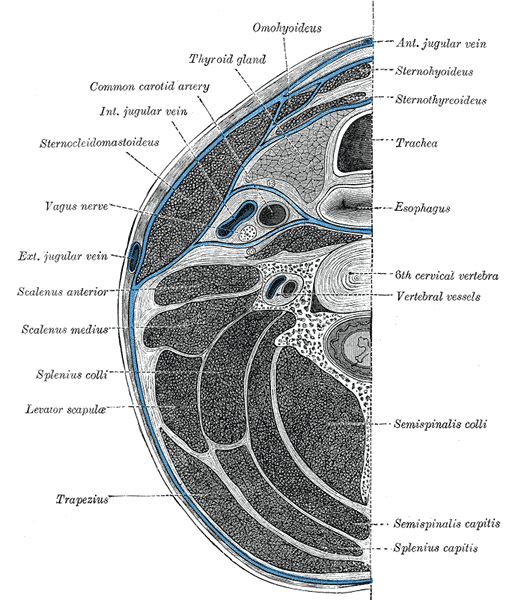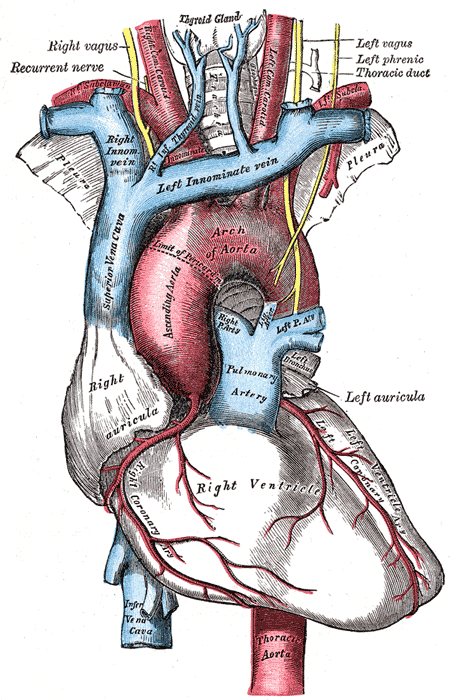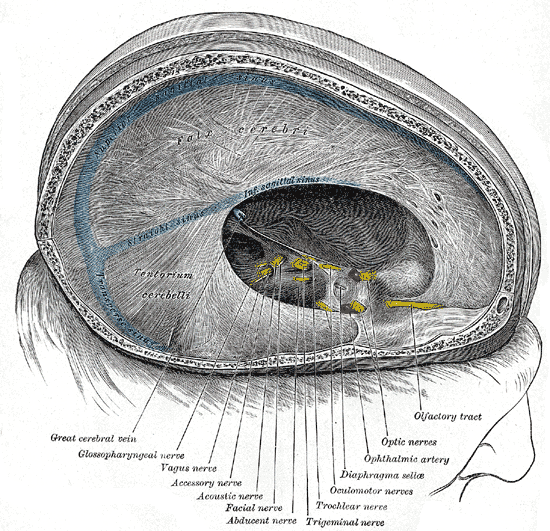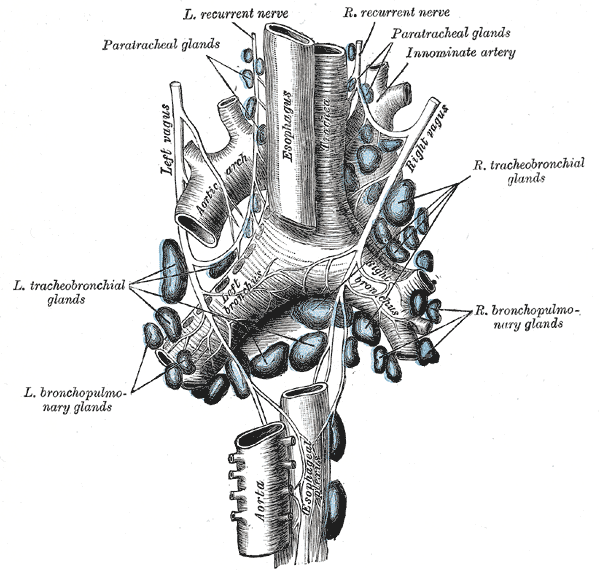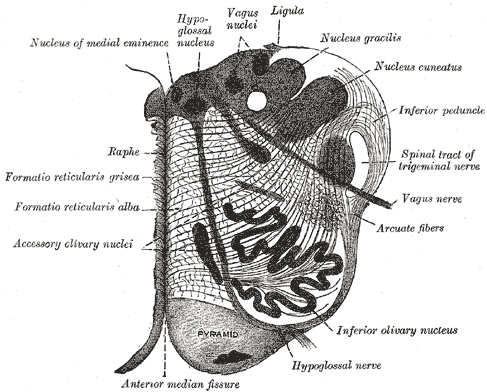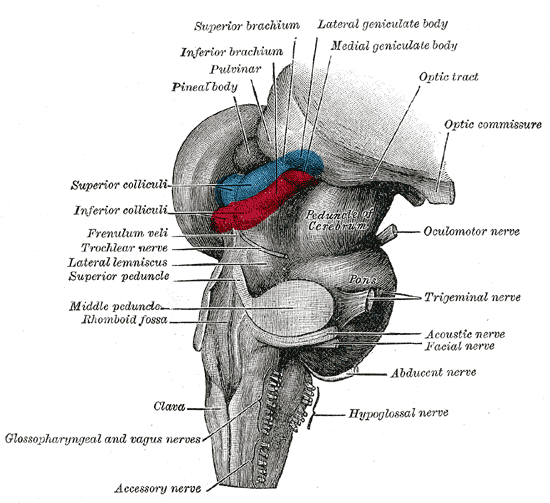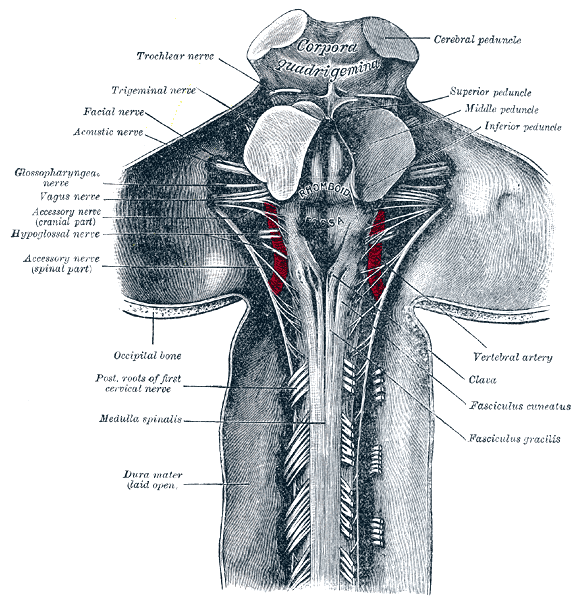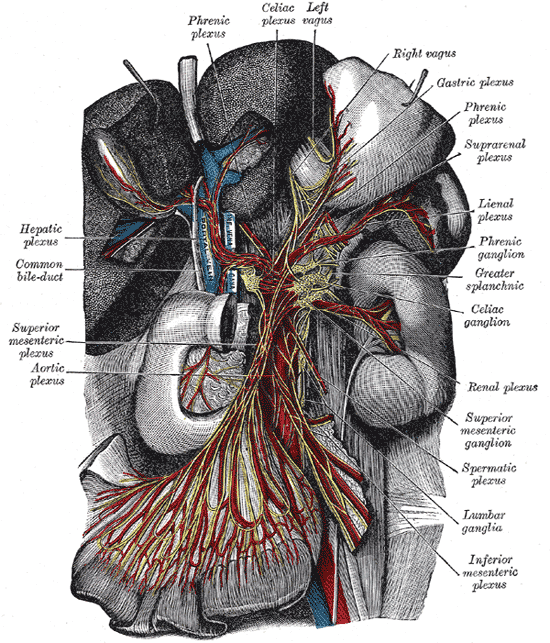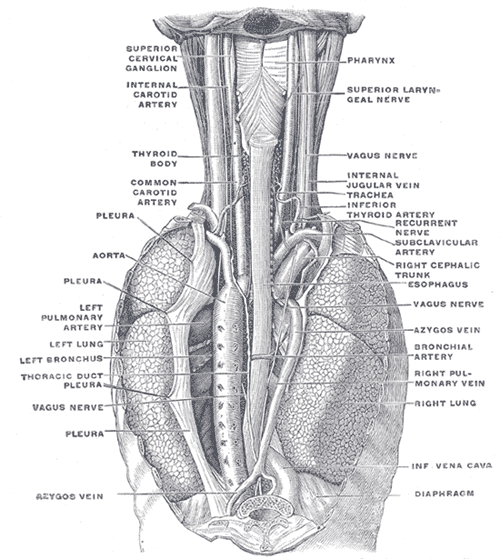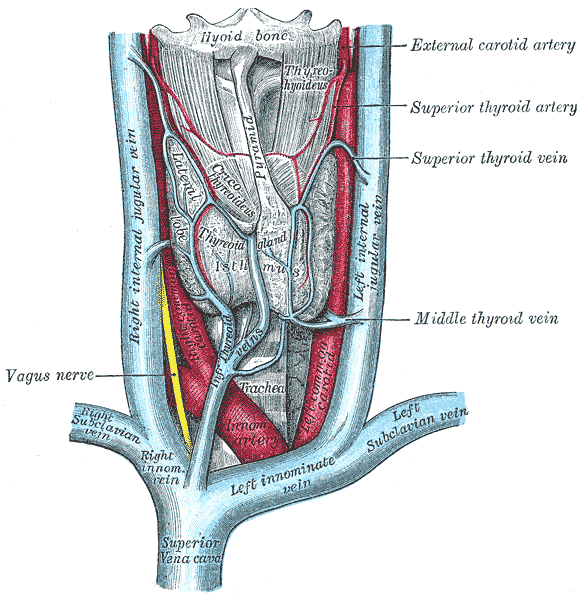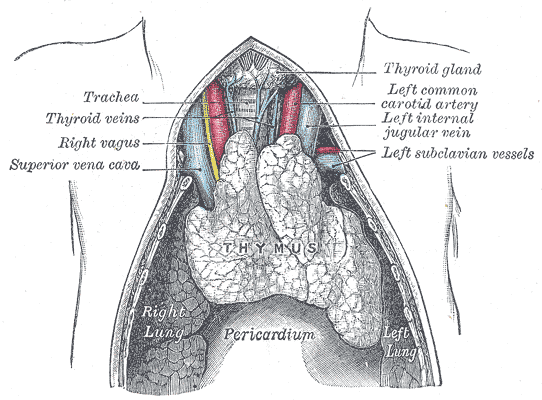Vagus nerve
Editor-In-Chief: C. Michael Gibson, M.S., M.D. [1] Template:Infobox Nerve
Overview
The vagus nerve (also called pneumogastric nerve or cranial nerve X) is the tenth of twelve paired cranial nerves, and is the only nerve that starts in the brainstem (within the medulla oblongata) and extends, through the jugular foramen, down below the head, to the neck, chest and abdomen.
The medieval Latin word vagus means literally "Wandering" (the words vagrant, vagabond, and vague come from the same root). It is also called the pneumogastric nerve since it innervates both the lungs and the stomach.
Branches
- Auricular
- Pharyngeal
- Superior laryngeal
- Superior cervical cardiac branches of vagus nerve
- Inferior cervical cardiac branch
- Recurrent laryngeal
- Thoracic cardiac branches
- Branches to the pulmonary plexus
- Branches to the esophageal plexus
- Anterior vagal trunk
- Posterior vagal trunk
Innervation
The vagus descends from the spinal cord in the carotid sheath, lateral to the carotid artery. It carries on past the aortic arch to dip inferiorly behind the left bronchus. Here it forms the pulmonary plexus, after giving rise to the recurrent laryngeal nerve.
The vagus nerve supplies motor parasympathetic fibers to all the organs except the suprarenal (adrenal) glands, from the neck down to the second segment of the transverse colon. The vagus also controls a few skeletal muscles, namely:
- Cricothyroid muscle
- Levator veli palatini muscle
- Salpingopharyngeus muscle
- Palatoglossus muscle
- Palatopharyngeus muscle
- Superior, middle and inferior pharyngeal constrictors
- Muscles of the larynx (speech).
This means that the vagus nerve is responsible for such varied tasks as heart rate, gastrointestinal peristalsis, sweating, and quite a few muscle movements in the mouth, including speech (via the recurrent laryngeal nerve) and keeping the larynx open for breathing. It also receives some sensation from the outer ear, via the Auricular branch (also known as Alderman's nerve) and part of the meninges.
The vagus nerve and the heart
Parasympathetic innervation of the heart is mediated by the vagus nerve. The right vagus innervates the sinoatrial node. Parasympathetic hyperstimulation predisposes those affected to bradyarrhythmias. The left vagus when hyperstimulated predisposes the heart to atrioventricular (AV) blocks.
At this location Otto Loewi first proved that nerves secrete substances called neurotransmitters which have effects on receptors in target tissues. Loewi described the substance released by the vagus nerve as vagusstoff, which was later found to be acetylcholine.
The vagus nerve has three associated nuclei, the dorsal motor nucleus, the nucleus ambiguus and the solitary nucleus.
Drugs that inhibit the muscarinic cholinergic receptor (anticholinergics) such as atropine and scopolamine are called vagolytic because they inhibit the action of the vagus nerve on the heart, gastrointestinal tract and other organs. Anticholinergic drugs increase heart rate and are used to treat bradycardia (slow heart rate) and asystole, which is when the heart has no electrical activity. Anticholinergic drugs relax the detrusor muscle and cause constipation which again involves the vagus nerve.
Bulimics and anorexics have high vagal activity which is associated with the arrhythmias seen in these patients.[citation needed]
Medical treatment involving the vagus nerve
Vagus nerve stimulation (VNS) therapy using a pacemaker-like device implanted in the chest is a treatment used since 1997 to control seizures in epilepsy patients and has recently been approved for treating drug-resistant cases of clinical depression.[1] A convenient, non-invasive VNS device that stimulates an afferent branch of the vagus nerve is also being developed and will soon undergo trials.
A degree of intermittent VNS can be achieved by daily breathing exercises (for example, Pranayama) over a period of several weeks. In some patients, such proactive relaxation exercises have been found to correlate with lower blood pressure and lower heart rate and more stable moods.[citation needed] The Valsalva maneuver may activate the vagus nerve and is a "natural" way to achieve the same effect in some patients. Patients with atrial fibrillation, supraventricular tachycardia and other illnesses may be trained to perform the valsalva maneuver (or find it for themselves).
Vagotomy (cutting of the vagus nerve) is a now-obsolete therapy that was performed for peptic ulcer disease. Vagotomy is currently being researched as a less invasive alternative weight loss procedure to gastric bypass surgery[2]. The procedure curbs the feeling of hunger and is sometimes performed in conjunction with putting bands on patients's stomachs, resulting in average weight loss of 43% at six months with diet and exercise[3]. Five pencil-sized scars are the result of the procedure.
See also:
- Porphyria This rare disorder can cause seizures and damage to the vagal nerve. Diagnosis, in some cases, may require DNA testing.
Physical and emotional effects
Activation of the vagus nerve typically leads to a reduction in heart rate, blood pressure, or both. This occurs commonly in the setting of gastrointestinal illness such as viral gastroenteritis or acute cholecystitis, or in response to other stimuli, including carotid sinus massage, Valsalva maneuver, or pain from any cause, particularly having blood drawn. When the circulatory changes are great enough, vasovagal syncope results. Relative dehydration tends to amplify these responses.
Excessive activation of the vagal nerve during emotional stress, which is a parasympathetic overcompensation of a strong sympathetic nervous system response associated with stress, can also cause vasovagal syncope because of a sudden drop in blood pressure and heart rate. Vasovagal syncope affects young children and women more often. It can also lead to temporary loss of bladder control under moments of extreme fear.
Research has shown that women who have complete transection of the spinal cord can experience orgasms through the vagus nerve, which can go from the uterus, cervix and probably the vagina to the brain.[2][4]
Effects of vagus nerve lesions
The patient complains of hoarse voice, difficulty in swallowing (dysphagia), pain during swallowing(odynophagia) and choking when drinking fluid. There is also loss of gag reflex. Uvula deviates away from the side of lesion and there is failure of palate elevation.
Additional images
-
Section of the neck at about the level of the sixth cervical vertebra.
-
Transverse section of thorax, showing relations of pulmonary artery.
-
The arch of the aorta, and its branches.
-
Dura mater and its processes exposed by removing part of the right half of the skull, and the brain.
-
The tracheobronchial lymph glands.
-
Section of the medulla oblongata at about the middle of the olive.
-
Hind- and mid-brains; postero-lateral view.
-
Upper part of medulla spinalis and hind- and mid-brains; posterior aspect, exposed in situ.
-
The right sympathetic chain and its connections with the thoracic, abdominal, and pelvic plexuses.
-
The celiac ganglia with the sympathetic plexuses of the abdominal viscera radiating from the ganglia.
-
The position and relation of the esophagus in the cervical region and in the posterior mediastinum. Seen from behind.
-
The thyroid gland and its relations.
-
The thymus of a full-term fetus, exposed in situ.
References
- ↑ Nemeroff C, Mayberg H, Krahl S, McNamara J, Frazer A, Henry T, George M, Charney D, Brannan S (2006). "VNS therapy in treatment-resistant depression: clinical evidence and putative neurobiological mechanisms". Neuropsychopharmacology. 31 (7): 1345–55. PMID 16641939. link
- ↑ http://www.msnbc.msn.com/id/19563617/
- ↑ http://www.cnn.com/2007/HEALTH/conditions/07/09/obesity.nerve.ap/index.html
- ↑ Komisaruk, B.R, Whipple, B., Crawford, A., Grimes, S., Liu, W-C., Kalin, A., & Mosier, K. (2004). "Brain activation during vaginocervical self-stimulation and orgasm in women with complete spinal cord injury: fMRI evidence of mediation by the Vagus nerves". link
External links
- CS1 maint: Multiple names: authors list
- All articles with unsourced statements
- Articles with unsourced statements from October 2007
- Articles with invalid date parameter in template
- Articles with unsourced statements from February 2007
- Peripheral nervous system
- Autonomic nervous system
- Cranial nerves
- Thorax
- Abdomen
